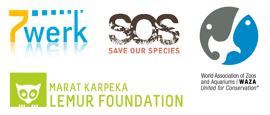Research
Statement on research in Sahamalaza-Iles Radama National Park (SIRNP) during the Covid-19 pandemic.
Owing to the global coronavirus (Covid-19) pandemic, and the risks of international and domestic transmission, AEECL are currently advising against all research in SIRNP.
Numerous cases of Covid-19 have been reported in Antsohihy, and the extent of the virus in local communities within SIRNP is unknown. Moreover, recent guidance from the IUCN stresses the importance of considering risks of Covid-19 transmission to non-human primates and other mammals, and details some of the recommended precautions that need to be taken. There is no Covid-19 testing infrastructure within SIRNP, and there are significant delays in obtaining Covid-19 test results in the major cities. It is therefore neither safe, practical, nor ethically acceptable for researchers to increase the risk of covid-19 transmission within SIRNP, and put local communities and wildlife in danger.
This statement on research in SIRNP will be updated as and when the Covid-19 situation in SIRNP changes.
Since the late 1980s, AEECL has implemented or financed a number of different research projects, mainly on the cytogenetics, taxonomy and distribution of lemur genera such as Hapalemur, Lepilemur, and Propithecus. The Sahamalaza region has been in AEECL’s focus of scientific and conservation interest since 1988.
During the course of 2004 a field station and a scientific working group were established by scientists within the AEECL and the Universities of Antananarivo and Mahajanga in the Ankarafa forest, situated within the Sahamalaza – Iles Radama National Park. It was soon realised that large gaps in the knowledge we have about the blue-eyed black lemur still remained. Together, the zoos united in AEECL aim to fill in some of these gaps, especially concerning population and social dynamics, habitat utilisation, nutritional ecology, and veterinary issues, to be able to develop comprehensive conservation and management plans for this and other Critically Endangered lemur species. The first three long-term research projects, namely on the nutritional ecology, socioecology and parasitic status of the blue-eyed black lemur, were carried out in Ankarafa.
This vital research work also increases public awareness for the forest ecosystem in the region and facilitates long-term conservation and research efforts for the lemurs and their habitat.
Other species that have been subject to studies and/or census work in Sahamalaza are the newly discovered Sahamalaza sportive lemur (Lepilemur sahamalazaensis) and the northern giant mouse lemur (Mirza zaza) as well as different bird species.


Our research in Sahamalaza and elsewhere in Madagascar aims at increasing the scientific understanding of endangered lemurs through the study of impacts of habitat degradation and fragmentation on their ecology and behaviour. Moreover, the speciation and distribution areas of different lemur taxa have been investigated in order to be able to assign a conservation status to those species and to implement effective conservation measures.
Studies conducted in Sahamalaza since 1999:
| Year | Study Topic | Researcher(s) |
| 1999 | Study on the population density of Eulemur macaco flavifrons in the Radama Peninsula [FR] | Rakotondratsima Marius |
| 1999 | Inventory of the flora and study on the forest formation in the Radama Peninsula [FR] | Ralimana Hélène and Ranaivojaona Rolland |
| 2000 | The hydrogeological assets of Sahamalaza [FR] | Rakotojoelimaria Rindra |
| 2000 | A preliminary socio-economical study in the Sahamalaza peninsula [FR] | Samby and Bevoavy |
| 2002 | A preliminary study of the bush pig population and analysis of the problems they cause in the Sahamalaza peninsula [FR] | Andrianjakarivelo Vonjy |
| 2002 | Census of amphibians, reptiles and insectivores of the Sahamalaza peninsula [FR] | Andreone F., Randrianirina J., Vences M. |
| 2002 | Study of the mitochondrial DNA sequence variability of E. macaco flavifronspopulations [FR] | Jean-Luc Fausser |
| 2003 | Inventory with a view to define the dispersion area and the distribution of the E. macaco flavifrons [FR] | Randriatahina Guy Hermas |
| 2003 | Study of the genetic variability of E. macaco flavifrons using microsatellites [FR] | Jean-Luc Fausser |
| 2004 | Inventory of sportive lemur populations in the Ankarafa forest, Sahamalaza. [FR] | Mathias Craul and Gillian Olivieri |
| 2004 | Contribution to the bio-ecological study of the Eulemur macaco flavifronspopulations in forest fragments in the Sahamalaza peninsula [FR] | Volampeno Sylviane |
| 2004 | Rapid assessment of the Eulemur macaco flavifrons population outside the Sahamalaza peninsula [FR] | Andrianjakarivelo Vonjy |
| 2004-2006 | Habitat use, activity patterns and a study of parasites and their transmission modes in theEulemur macaco flavifrons [FR] | Nora Schwitzer |
| 2004-2006 | Nutrition and the spatio-temporal distribution of food in the Eulemur macaco flavifrons [FR] | Christoph Schwitzer |
| 2004-2008 | Study on the social organisation of E. m. flavifrons groups in the Ankarafa forest [FR] | Randriatahina Guy Hermas |
| 2005 | Dietary behaviour of the Eulemur macaco flavifrons [FR] | Randrianarisoa Aimée Lucienne |
| 2005 | Diurnal activity of Eulemur macaco flavifrons [FR] | Tyann Marsh |
| 2006 | Contribution to the knowledge of the sacred ibis of Madagascar Threskiornis bernieri inSahamalaza [FR] | Andrianarimisa |
| 2006 | Cytogenetic and molecular study of sportive lemurs in the Sahamalaza peninsula: discovery of a new species L. sahamalazensis [FR] | Andriaholinirina Nicole et al. |
| 2007 | Population density and habitat use of Lepilemur sahamalazensis [EN] | Felicia Ruperti and Rabesandrasana Paul Miki |
| 2008 | Habitat preferences of Lepilemur sahamalazensis [EN] | Felicia Ruperti |
| 2008 | Participatory mapping of the Ankarafa Forest [EN] | Jamie Smith and James Thorn |
| Ongoing | Study of Eulemur macaco flavifrons: social development in youngsters, maternal behaviour, estimation of the population density and description of their habitat [FR] | Volampeno Sylviane |

